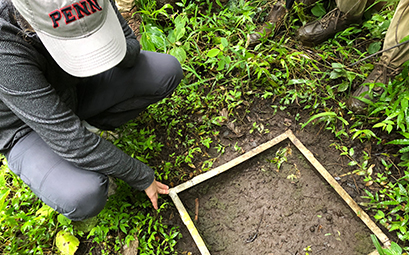Biological and Cultural Diversity of South Indian Landscapes: Vegetation of the Mudumalai Vayals
Curatorial Section
Research Discipline
Anthropology
Expand Global Research
Over more than a century, we’ve opened up endless exploration across six continents. New field work endowments will ensure our continued leadership in national and international field research and discovery.
Give NowHumans are often seen as a threat to biodiversity and conservation, but humans can preserve and create biodiverse landscapes. A new joint Penn-India project focuses on Mudumalai in southern India and explores the human and nonhuman histories of this culturally and biologically diverse region.
- Time Period Studied
-
Investigation of the Mudumalai wetlands, or vayals, is part of a larger research project considering the long-term human and natural histories of the region. Cores provide evidence of human activity from the present into the past – we don’t yet know how old the base of the cores are, but we are hoping for as much as a thousand years of change.
- Location Information
-
This project explores the swamps, or vayals, of Mudumalai, located in the Western Ghat Mountains in southern India.
- Researcher(s)
-
- Kathleen Morrison, Sally and Alvin V. Shoemaker Professor of Anthropology, Department Chair, University of Pennsylvania; Curator, Asian Section, Penn Museum
- Mark Lycett, Adjunct Professor, South Asian Studies and Anthropology, Director of South Asia Center, University of Pennsylvania
- Raman Sukumar, H.S. Suresh, Centre for Ecological Sciences, Indian Institute of Science, Bangalore
- Shanti Pappu, Sharma Centre for Heritage Education, Chennai
- K. Anupama, French Institute, Pondicherry University
- Ramyabalara Prabhakaran, Postdoctoral Scholar, University of Pennsylvania, Fulbright-Kalam Climate Fellow.
- Project Description
-
Mudumalai National Park is one of several interconnected protected areas located in the rugged and inaccessible Western Ghat Mountains in southern India. This ‘megadiverse’ region is home to many tigers, elephants, and other charismatic wildlife. In an effort to preserve this ‘natural’ landscape, access to the area is strictly controlled by the Forest Department and other agencies. Conservation thinking often places humans in direct opposition to biodiversity, but humans can preserve, and even create biodiverse landscapes. While in the last century this region was seen as a domain of nature, the Ghat uplands were the source of many valuable premodern and early modern trade commodities, such as forest-derived gums, resins, dyes, and spices like black pepper, the “king of the spice.” Mountain farmers and foragers grew and gathered forest products, attracting international trade and, eventually, colonizers.
A more accurate, historically-informed understanding of the past, including when and how changes in land use and land cover have reduced, maintained, or expanded biodiversity, may help better address the present and future of this environmentally-rich region. In the summer of 2018, Morrison and Lycett traveled to Mudumalai to begin a long-term research project on human land use, landscape, and environmental transformations in this important ecosystem. With the help of the Indian Institute of Science, Bangalore, and the Forest Department, Morrison and Lycett visited several swamps or vayals, scouting out sampling locations for a study of long-term vegetation history. In the dry season, they will revisit these vayals with boats and coring equipment to take samples for the analysis of pollen grains, phytoliths, stable isotopes, and other biomarkers. Over the next several years, a collaborative Penn-India team will carry out archaeological survey, excavation, and archival research in order to better understand the entangled human-nonhuman histories of this biodiverse landscape.
- Partners and Collaborators
-
- Indian Institute of Science, Bangalore
- Forest Department
- Resources & More Information
-
Human Dimensions of Biodiversity
Vijayanagara Metropolitan Survey
PAGES? (LandCover6K)








